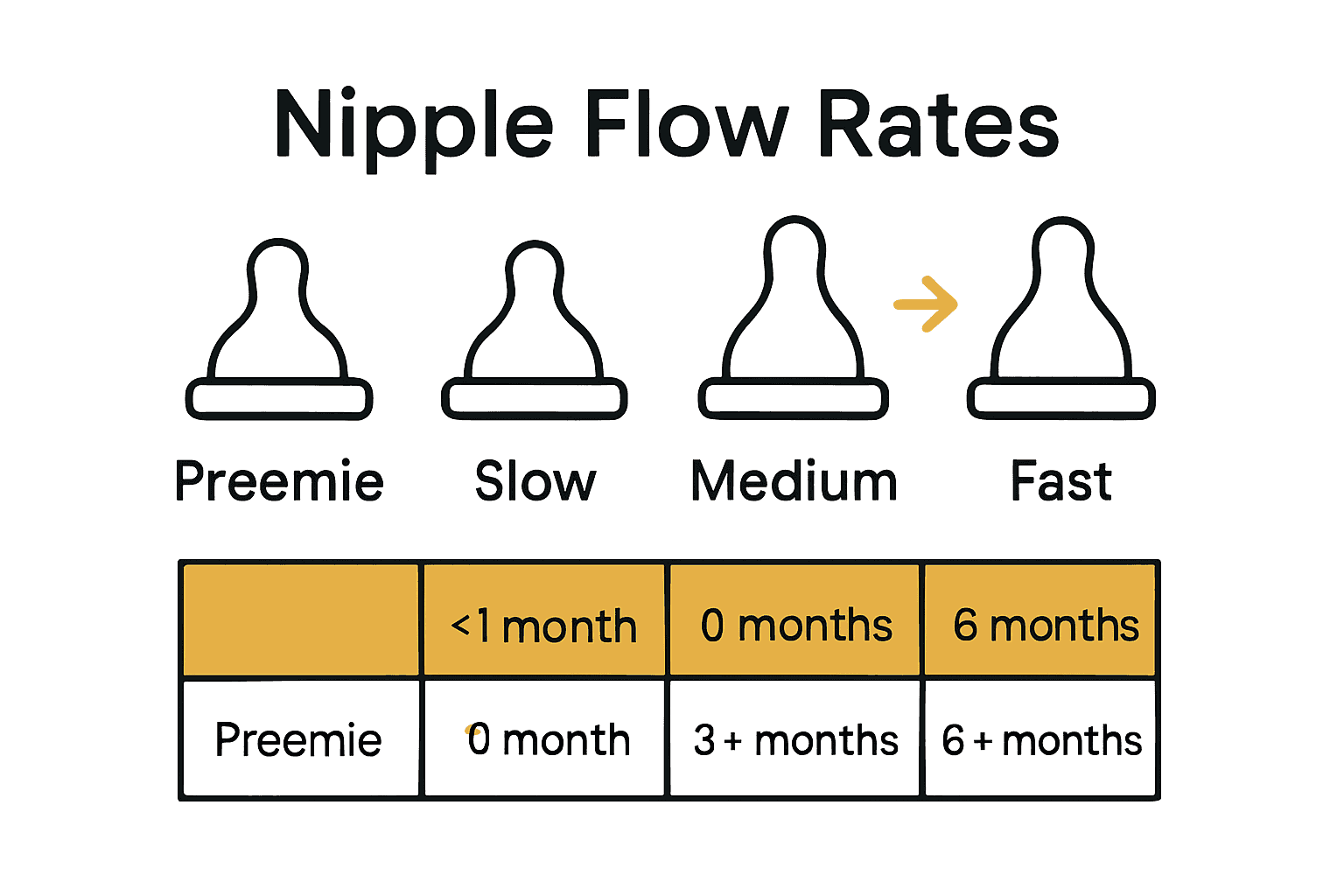
Nipple Flow Rates: Everything You Need to Know

Most parents are surprised to learn that the flow rate of a bottle nipple can make or break a feeding routine. This simple detail affects how easily your baby drinks, how much milk they get, and even their comfort with each bottle. With bottle nipples ranging from barely a trickle to a fast rush—some flow as slowly as 1.68 mL per minute, others rocket up to 85.34 mL—choosing the right one is a key step to happy, healthy feeding and fewer worries about fussing or feeding troubles.
Key Takeaways
| Point | Details |
|---|---|
| Importance of Nipple Flow Rate | The flow rate of bottle nipples is vital for infant feeding, affecting both comfort and nutrition. Selecting the correct flow rate helps prevent feeding frustration or choking hazards. |
| Flow Rate Classifications | Nipple flow rates are categorized into levels, from Preemie (Level 0) for weak suckers to Fast (Level 3) for older infants, ensuring an appropriate match for age and feeding skill. |
| Monitoring Feeding Behavior | Parents should observe signs of discomfort during feeding, such as frustration or choking, which indicate potential flow rate mismatches that may need adjustment. |
| Consultation and Adaptation | Regularly reassess and, if necessary, adjust the nipple flow rate in consultation with a pediatrician to support optimal feeding development in growing infants. |
Defining Nipple Flow Rates in Baby Feeding
Nipple flow rate is a critical yet often overlooked aspect of infant feeding that can significantly impact your baby's comfort and nutrition. Simply put, it refers to the speed at which milk or formula passes through a bottle nipple into your infant's mouth. Think of it like a water faucet - some streams are gentle trickles, while others are powerful jets.
According to medical experts at Nationwide Children's Hospital, selecting an appropriate flow rate is crucial for your baby's feeding experience. A flow rate that is too slow may cause your baby to exert excessive effort during feeding, potentially leading to frustration and exhaustion. Conversely, a flow rate that is too fast can overwhelm your little one, causing choking, coughing, or potential feeding difficulties.
Flow rate classifications typically follow these standard categories:
- Level 1 (Slow Flow): Ideal for newborns and babies 0-3 months
- Level 2 (Medium Flow): Suitable for infants 3-6 months
- Level 3 (Fast Flow): Recommended for babies 6+ months or with more developed feeding skills
Understanding these flow rate nuances helps parents make informed decisions.
 As babies grow and develop stronger sucking muscles, they require nipples that match their evolving feeding capabilities. Pediatric guidance suggests regularly reassessing and adjusting nipple flow rates to ensure your baby's feeding remains comfortable, efficient, and developmentally appropriate.
As babies grow and develop stronger sucking muscles, they require nipples that match their evolving feeding capabilities. Pediatric guidance suggests regularly reassessing and adjusting nipple flow rates to ensure your baby's feeding remains comfortable, efficient, and developmentally appropriate.
Types of Nipple Flow Rates Explained
Nipple flow rates represent a crucial spectrum of milk delivery designed to match your baby's developmental stages and feeding capabilities. Experts typically categorize these rates into several distinct types, each tailored to support different infant age groups and feeding requirements. Understanding these variations can help you select the most appropriate nipple for your baby's specific needs.
According to Nationwide Children's Hospital research, nipple flow rates are commonly labeled with descriptive terms and numerical indicators.
The standard classifications include:
Here's a comparison of common nipple flow rate levels and their typical uses:
| Flow Level | Age/Developmental Stage | Typical Indications |
|---|---|---|
| Preemie (Level 0) | Premature infants | Weak sucking ability<br>Special feeding needs |
| Slow (Level 1) | Newborns (0-3 months) | Learning to feed<br>Preference for gentle flow |
| Medium (Level 2) | 3-6 months | Developing stronger suck<br>Transition phase |
| Fast (Level 3) | 6+ months | Mature sucking skills<br>Increased milk needs |
- Preemie Flow (Level 0): Extremely slow flow for premature infants or babies with weak sucking abilities
- Slow Flow (Level 1): Designed for newborns and young infants aged 0-3 months
- Medium Flow (Level 2): Suitable for babies 3-6 months with developing feeding skills
- Fast Flow (Level 3): Recommended for infants 6+ months with stronger sucking muscles
Selecting the right flow rate is more than a simple age-based decision. Factors like your baby's individual feeding strength, whether they are breastfed or bottle-fed, and their unique sucking pattern all play significant roles. A mismatch can lead to feeding challenges such as frustration, excessive air intake, or potential feeding refusal.
 Pediatric experts recommend observing your baby's feeding behavior and being prepared to adjust nipple flow rates as they grow and develop.
Pediatric experts recommend observing your baby's feeding behavior and being prepared to adjust nipple flow rates as they grow and develop.
How Flow Rates Impact Feeding Outcomes
Feeding outcomes are profoundly influenced by nipple flow rates, representing a delicate balance between infant nutrition and comfortable feeding experience. Research reveals that the wrong flow rate can dramatically disrupt a baby's natural feeding rhythm, potentially leading to significant developmental and nutritional challenges.
A groundbreaking study published in PubMed demonstrated remarkable variability in milk flow rates, ranging from as low as 1.68 mL/min to an extreme 85.34 mL/min. This wide spectrum underscores the critical importance of selecting the right nipple flow rate. St. George's Hospital research highlights that inappropriate flow rates can cause serious feeding complications:
- Too Fast: Potential risks include
- Choking hazards
- Milk spillage
- Overwhelming the infant's swallowing mechanism
- Too Slow: Potential consequences include
- Feeding frustration
- Inadequate nutritional intake
- Extended feeding times
Understanding these nuanced impacts requires parents to become keen observers of their infant's feeding behavior. Experts recommend watching for subtle cues like consistent coughing, milk dribbling, apparent frustration, or unusual pauses during feeding. These signs can indicate a mismatched nipple flow rate, signaling the need for careful reassessment and potential adjustment to support your baby's optimal feeding development.
Risks, Signs, and Solutions for Flow Rate Issues
Flow rate challenges can transform a peaceful feeding session into a stressful experience for both babies and parents. Understanding the subtle signs of nipple flow rate problems is crucial for maintaining a smooth, comfortable feeding routine. Nationwide Children's Hospital experts emphasize that recognizing these issues early can prevent potential feeding complications.
Identifying Flow Rate Warning Signs
Parents should watch for specific indicators that suggest a mismatched nipple flow rate:
Signs of Too Slow Flow:
- Baby becomes visibly frustrated during feeding
- Increased effort to extract milk
- Extended feeding times
- Falling asleep mid-feed due to exhaustion
- Reduced total milk intake
Signs of Too Fast Flow:
- Frequent choking or coughing while feeding
- Milk leaking from the sides of mouth
- Pulling away from bottle frequently
- Apparent discomfort or distress during feeding
- Excessive gas or air intake
Addressing flow rate issues requires a proactive and observant approach. Pediatric feeding specialists recommend a systematic method of assessment and adjustment. Start by carefully monitoring your baby's feeding behavior, noting any consistent patterns of discomfort or inefficient milk consumption. If you suspect a flow rate mismatch, consider consulting with your pediatrician or experimenting with different nipple levels to find the optimal match for your baby's developmental stage and individual feeding capabilities.
Tips for Choosing the Right Nipple Flow
Selecting the perfect nipple flow is more art than science, requiring keen observation and understanding of your baby's unique feeding characteristics. Nationwide Children's Hospital emphasizes that age recommendations on packaging are merely guidelines, not strict rules. Every baby develops feeding skills differently, making personalized assessment crucial for successful bottle feeding.
Key Considerations for Nipple Flow Selection
When choosing the right nipple flow, parents should focus on several critical factors:
Feeding Style Indicators:
- Observe baby's sucking strength
- Monitor feeding duration
- Watch for signs of frustration or ease
- Consider breastfeeding frequency
- Assess overall comfort during feeding
Recommended Selection Strategy:
- Start with the slowest flow rate
- Watch baby's feeding behavior closely
- Look for consistent, comfortable feeding patterns
- Gradually adjust flow rate if needed
- Consult pediatrician for personalized guidance
Special attention is necessary for babies transitioning between breast and bottle feeding. A slower nipple flow can help maintain a feeding rhythm similar to breastfeeding, reducing potential nipple confusion and supporting a smoother feeding transition. Remember, patience and careful observation are your best tools in finding the perfect nipple flow for your little one.
Find the Perfect Nipple Flow Rate for Your Baby's Comfort
Feeding your baby should be a joyful and stress-free experience, but choosing the wrong nipple flow rate can cause frustration, choking, or prolonged feeding times. This article highlights the importance of matching nipple flow rates to your baby’s unique sucking ability and developmental stage. If you have noticed signs like coughing, pulling away, or fussiness during feedings, these could be clear signals that a nipple adjustment is overdue.
At Family Bottle Fit we understand the challenges parents face when selecting the ideal bottle and nipple that suits their baby’s feeding style. Our comprehensive guides and practical tools help you customize bottle components like nipples, vents, and materials for safer, smoother feeding sessions. Don’t wait until mealtime becomes a struggle. Visit Family Bottle Fit now to learn how to make informed choices that enhance your baby’s feeding comfort. Take control of feeding today and experience calmer, more effective bottle times.
Frequently Asked Questions
What are nipple flow rates?
Nipple flow rates refer to the speed at which milk or formula passes through a bottle nipple into an infant's mouth, impacting feeding comfort and effectiveness.
How do I know which nipple flow rate is suitable for my baby?
Choosing the right nipple flow rate depends on your baby's age, feeding skills, and comfort. Typically, use slow flow (Level 1) for newborns, medium flow (Level 2) for babies 3-6 months, and fast flow (Level 3) for infants 6 months and older.
What are the signs of a mismatched nipple flow rate?
Signs of a mismatched flow rate include frustration during feeding, extended feeding times, choking, excessive gas, or milk leaking from the mouth. Observing these behaviors can help identify if you need to adjust the nipple flow.
How can I choose the right nipple for transitioning from breast to bottle feeding?
For a smoother transition, start with a slower nipple flow to mimic breastfeeding. This helps maintain a similar feeding rhythm, reducing the risk of nipple confusion and supporting overall comfort during bottle feeding.
Related Articles


Why Slow Flow Nipples Matter: Complete Guide

Step-by-Step Guide to Preventing Nipple Confusion Easily

Complete Guide to the Role of Bottle Construction

